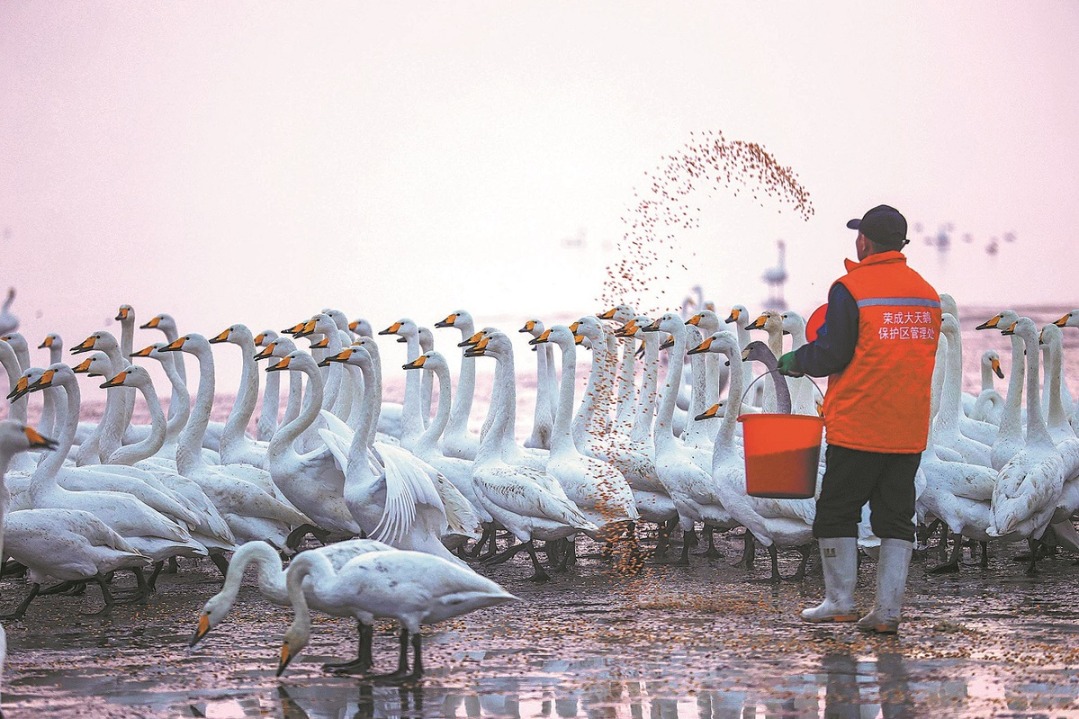Stations give 'paws' for thought
Themed modular structures offer visitors a wealth of information on nature through unique and interactive experiences, Yang Feiyue reports.

The distinctive red exterior of a nature station features hollowed-out leopard images and extruding lion shapes that pique one's curiosity. It distinctively contrasts against the vast green backdrop of Metog county of Nyingchi in the Xizang autonomous region.
Stepping inside, people are immediately drawn into a fascinating world of information about the large cats, including an artistically designed evolutionary tree showcasing the eight lineages of 40 species.
After seeing the big picture, visitors may find more details while exploring further into the space, ranging from illustrations about local species in the county to magnified pictures of big felines, such as leopards, Bengal tigers and snow leopards, as well as how their feces can be used to identify them and analyze their DNA.
"We have added many interactive devices, such as a rolling drum that allows visitors to piece together different felines and a button to hear feline howls," says Guo Yingqian from Chinese National Geography magazine, which constructed the nature station.
Paws on the floor, eyes staring down from the ceiling and visual explanations of the large cats' eating habits adorn the space, creating a lifelike vibe.
The station, along with two similar stations that highlight Metog's geology and orchids, was the latest addition to the county's Lianhua central square in late October.
Earlier last year, the Chinese National Geography established three other stations to introduce the county's giant trees, birds and butterflies.
They have formed a matrix to inform visitors of what gives Metog its special identity, says Guo, who is in charge of the stations' designs and operations.
"These six thematic stations offer a comprehensive understanding of the area," she adds.
Each nature station incorporates a modular structure that can be customized to suit the natural, geological and cultural characteristics of different destinations. Modules can be stacked and combined based on the richness of the display content, allowing for adaptability to various settings.
Each station is the size of a shipping container — 5 meters long, 2 meters wide and over 3 meters tall — and is equipped with as many as 18 interactive devices, more than a typical urban museum.
"The Metog nature stations serve multiple purposes. They employ a range of media — models, hand-drawn illustrations, interactive devices and videos — to comprehensively showcase Metog's biodiversity and geographical features," she notes.
These stations reflect over 70 years of content innovations by the magazine, which is hosted by the Chinese Academy of Sciences.
"The content we produce is built on the foundation of extensive research and expertise from many researchers," Guo says.
Typically, for each topic, a group of researchers in geology, plants and animals will work together to organize and present content in a fun, engaging way.
"The approach taken to introduce these key points is both interesting and systematic. We have dedicated significant thought to presenting the content in an innovative manner," Guo says.
The opportunity arose as China's culture and tourism industry entered a new phase, with travelers displaying a growing desire to genuinely comprehend a region, rather than relying solely on local legendary tales.
"Based on this idea, we began exploring each area's uniqueness, hoping to uncover the authentic charm of each region in the country and convey it simply and effectively to allow people to really experience it," Guo says.
The stations aim to provide a natural interpretation of each destination.
"We delve into the distinctive geological formations, the unique features they possess, the special flora and fauna that inhabit the region, the intriguing insects that thrive there, and the rich cultural traditions that have been passed down through generations. Exploring these facets consistently reveals their distinct characteristics," she says.
Guo's team has set its sights on almost 50 unique areas boasting major natural belts and ecosystems.
The chosen one
Metog was selected as one of the initial locations for implementing the nature station project due to its nine significant natural zones that extend vertically from snowy mountains to tropical rainforests.
"These nine natural zones are typically dispersed horizontally in other regions," Guo explains.
"In just three hours, you can journey from mountains to rainforests here, experiencing a swift shift from snowcapped summits to lush tropical flora. This location encapsulates the essence of diverse ecosystems worldwide," she elaborates.
Given the area's complex climate conditions, the stations are built using eco-friendly materials.
"We intend for each station to be a landscape installation within nature," Guo says.
Some stations, including the giant tree one, achieve zero-carbon consumption.
"The tree-shaped structure was created with photovoltaic panels on top, making it self-sufficient in power supply," Guo says, adding that over 80 percent of the materials inside are made with wood.
Visitors become immersed in stories about giant trees that tell how they grow to such impressive heights — some more than 70 meters — and how they can be a vertical ecosystem hosting over 50 species of plants and animals.
According to an April survey conducted by the magazine on user experiences from the first three nature stations, more than 80 percent of visitors engaged in the interactive experiences for more than 90 seconds.
"It showed a strong interest in these experiences," Guo says.
Additionally, more than 60 percent of users tried the same experiences more than three times, indicating a strong desire to explore and memorize relevant knowledge.
The Metog nature stations recently won gold in the Architectural Design Installations category at the 2024 Global Architecture Design Awards.
"The nature stations in Metog county showcase the brand philosophy in a unique area known for its nine vertical natural zones. This region experiences plate collisions, water vapor condensation and distinct climate conditions that contribute to its rich and diverse ecosystem. The nature stations emphasize this uniqueness with themes such as orchids, butterflies and large cats, enticing visitors to explore further," the judges panel of the awards commented.
In November, the nature stations were among 68 cases named as a model for integrating transportation and tourism development by several government organs, including the Ministry of Culture and Tourism and the Ministry of Transport.
Investment in vitality
Many nature stations are in the works across the country, including themes on peach blossoms in Nyingchi and desert animals in the Taklimakan Desert in the Xinjiang Uygur autonomous region.
"We are expecting about 15 nature stations up and running by June," Guo says.
Wang Changbing, general manager of a scenic area investment company in Changji Hui autonomous prefecture, Xinjiang, believes the Chinese National Geography's initiative to build nature stations is "a significant step forward in the integration of the digital and cultural tourism industries".
"Focusing on the application of three-dimensional scenic spaces and human-machine interactions, the initiative not only aids scenic area operations in achieving better economic outcomes but also injects vitality and creativity into the fusion of cultural tourism with other industries," Wang says.
He hopes more nature stations will be built in scenic areas, and cultural tourism enterprises in Xinjiang will soon benefit from this project.
Guo Min, an official in charge of themed postal office by China Post's operations in Beijing, says nature stations represent a new exploration into the integration of transportation and tourism.
"By fully utilizing diverse experiences to convey the energy of local cultural tourism, it creates a wonderful space that is tangible, perceptible and experiential, which enhances a sense of fulfillment, engagement and connection with nature during travel," Guo Min says.
Guo Mingfei, an official from Sansha Nanhai Dream Cruises in Hainan, says she is excited to see how nature stations integrate with local characteristics.
"We eagerly expect the establishment of nature stations on the Xisha Islands, allowing visitors, especially research and study groups, to experience nature firsthand and gain authoritative insights into marine biology, meteorology, and the ecology of reefs and birds," Guo Mingfei says.




Today's Top News
- China, France issue joint statements
- Xi, Macron have friendly exchanges in China's Chengdu
- Unity urged to advance Global South development
- Rule of law guards sound business environment
- Resilience of Sino-French economic ties hailed
- Xi, Macron vow to deepen relations






























